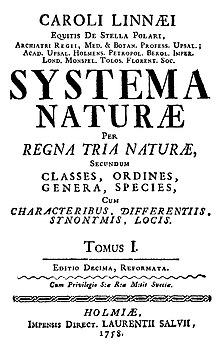Systema Naturae

Title page of the 1758 edition of Linnaeus's Systema Naturæ.
|
|
| Author |
Carolus Linnaeus (Carl von Linné) |
|---|---|
| Country | Sweden |
| Subject | Taxonomy |
| Genre | Biological classification |
|
Publication date
|
1735 |
| LC Class | QH43 .S21 |
Systema Naturae (sometimes written Systema Naturæ with the ligature æ) is one of the major works of the Swedish botanist, zoologist and physician Carolus Linnaeus (1707–1778) and introduced the Linnaean taxonomy. Although the system, now known as binomial nomenclature, was partially developed by the Bauhin brothers, Gaspard and Johann, 200 years earlier, Linnaeus was first to use it consistently throughout his book. The first edition was published in 1735. The full title of the 10th edition (1758), which was the most important one, was Systema naturæ per regna tria naturæ, secundum classes, ordines, genera, species, cum characteribus, differentiis, synonymis, locis or translated: "System of nature through the three kingdoms of nature, according to classes, orders, genera and species, with characters, differences, synonyms, places".
The tenth edition of this book (1758) is considered the starting point of zoological nomenclature. In 1766–1768 Linnaeus published the much enhanced 12th edition, the last under his authorship. Another again enhanced work in the same style and entitled "Systema Naturae" was published by Johann Friedrich Gmelin between 1788 and 1793. Since at least the early 1900s zoologists commonly recognized this as the last edition belonging to this series. It was also officially regarded by the International Commission on Zoological Nomenclature in Opinion 296 (26 Oct 1954) as the 13th edition of Systema Naturae.
Linnaeus (later known as "Carl von Linné", after his ennoblement in 1761) published the first edition of Systema Naturae in the year 1735, during his stay in the Netherlands. As was customary for the scientific literature of its day, the book was published in Latin. In it, he outlined his ideas for the hierarchical classification of the natural world, dividing it into the animal kingdom (regnum animale), the plant kingdom (regnum vegetabile), and the "mineral kingdom" (regnum lapideum).
...
Wikipedia
